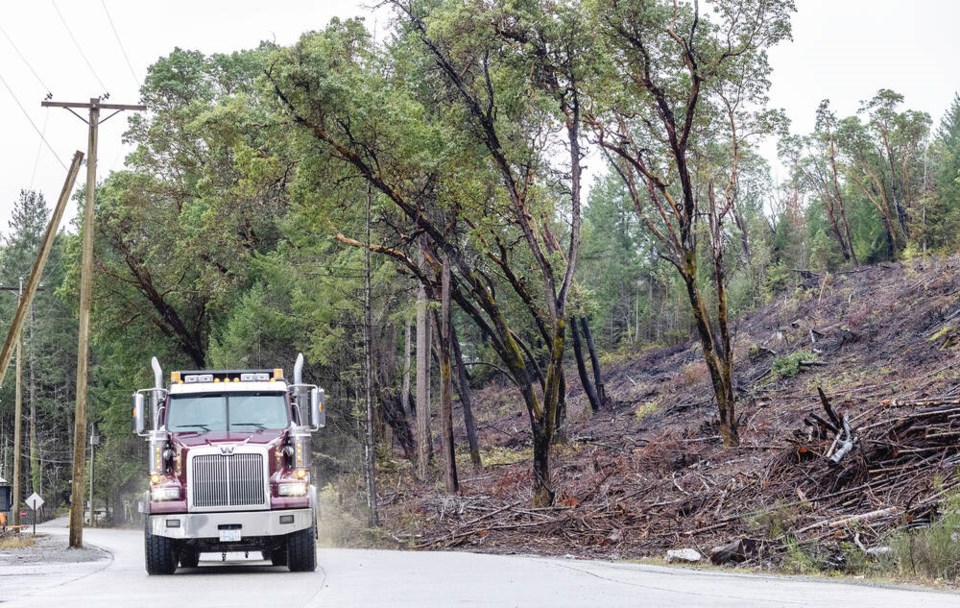One of the toughest driving manoeuvres I have to keep conquering out there is passing a semi-trailer.
It’s doubly tough when you’re in one of those “no escape” scenarios — sandwiched in between a concrete centre median on your left and an up to 80,000 pound behemoth in the right hand lane.
It’s worse still when the weather’s bad with rain, snow and road spray cutting visibility down to nearly nothing and the only thing between you and calamity is the skill and good judgment of the driver of that rig next to you.
However, going by a series of news items these past weeks, I’m also concerned about the mechanical condition of those semis we have to share the road with every day.
B.C.’s Commercial Vehicle Safety and Enforcement branch recently released stats that were, to put it mildly — shocking.
Inspectors conducted 27,800 inspections of commercial vehicles last year and only 1,800 passed — 6.5 per cent.
During those inspections, 7,500 commercial vehicles were in such bad condition they were immediately removed from the road.
So, aside from pondering the skill and judgment of the semi drivers I’m passing, now I wonder if they even have a side mirror to spot me or enough brakes to keep us out of harm’s way during a bad moment.
How did we get here?
Driving semis is a tough job. It demands long hours, often in very tough conditions, but we’ve piled enormous pressure on transport companies to get our goods to us cheaper and faster than ever. Post COVID, inflation and supply chain breakdowns worldwide are also helping to push systems to the breaking point.
Adding to all that, the commercial driver deals with safety and regulatory regimes that are probably deeper than some of the canyons they have to navigate.
For example, the CVSE’s information webpage has 75 links on it — each one connecting to more multi-page documents governing the conduct of commercial vehicles and their operators. That’s just at the provincial level. The feds have their own comprehensive set of rules and every town has by-laws around what semis can and can’t do.
Compliance isn’t cheap and that can lead to cutting regulatory corners. A brake job on a semi tractor runs around $2500 to $3000 so why not leave it for another few months? Time is also money, so a little unofficial change in a log book here and there can help with the bottom line, especially in the face of hefty fuel prices.
A recent CVSE campaign on highway 5 north of Kamloops, highlights the issue. Inspectors issued 159 tickets in February alone — 103 of them for speeding.
Adding to trucking industry woes is an ongoing shortage of drivers. The average age of a trucker, according to the Conference Board of Canada, is 46. One in four truckers is in the 55 to 64 age bracket. This puts even more pressure on the industry owners to push their reduced fleets to the max to deliver all those goods to our shelves.
While these factors might start to explain why we seem to be experiencing a rash of safety incidents around heavy vehicles on B.C. roads — they are not an excuse.
Big rigs out-weigh the rest of us on the road by tonnes. Collisions, particularly those that occur at speed, often have catastrophic consequences — and it’s not only the human toll. Cleaning up the aftermath of one of these crashes can take hours, even days, often involving the closure of major arterial routes.
Recall the 2011 crash of a semi fuel-tanker that smashed into the rocks near Goldstream park, dumping tens of thousands of litres of fuel into the river and closing the Malahat for 14 hours. In fairness, that was an impaired driving incident, but I mention it as one example of the huge effects these incidents leave in their wake.
Even the trucking industry agrees that more needs to be done. Recently, the president of the B.C. Trucking Association called for more frequent and ongoing roadside inspections throughout the province, despite the fact that they must already undergo mandatory inspections, twice a year.
Another problem might be lax inspection protocols. In 2020, a Vancouver mechanic shop was fined $24,000 and banned from government inspection work for faking inspection reports — allowing some 40 vehicles to improperly hit the road.
We require complex, powerful machines to haul goods — and alert competent professionals to operate them. That’s the way it is and anyone undertaking that work simply has to accept that.
If it requires more resources to increase inspections and enforcement to force some of these owners and operators to smarten up, then so be it. The current commercial vehicle inspection failure rate speaks for itself and can’t be ignored any longer.



